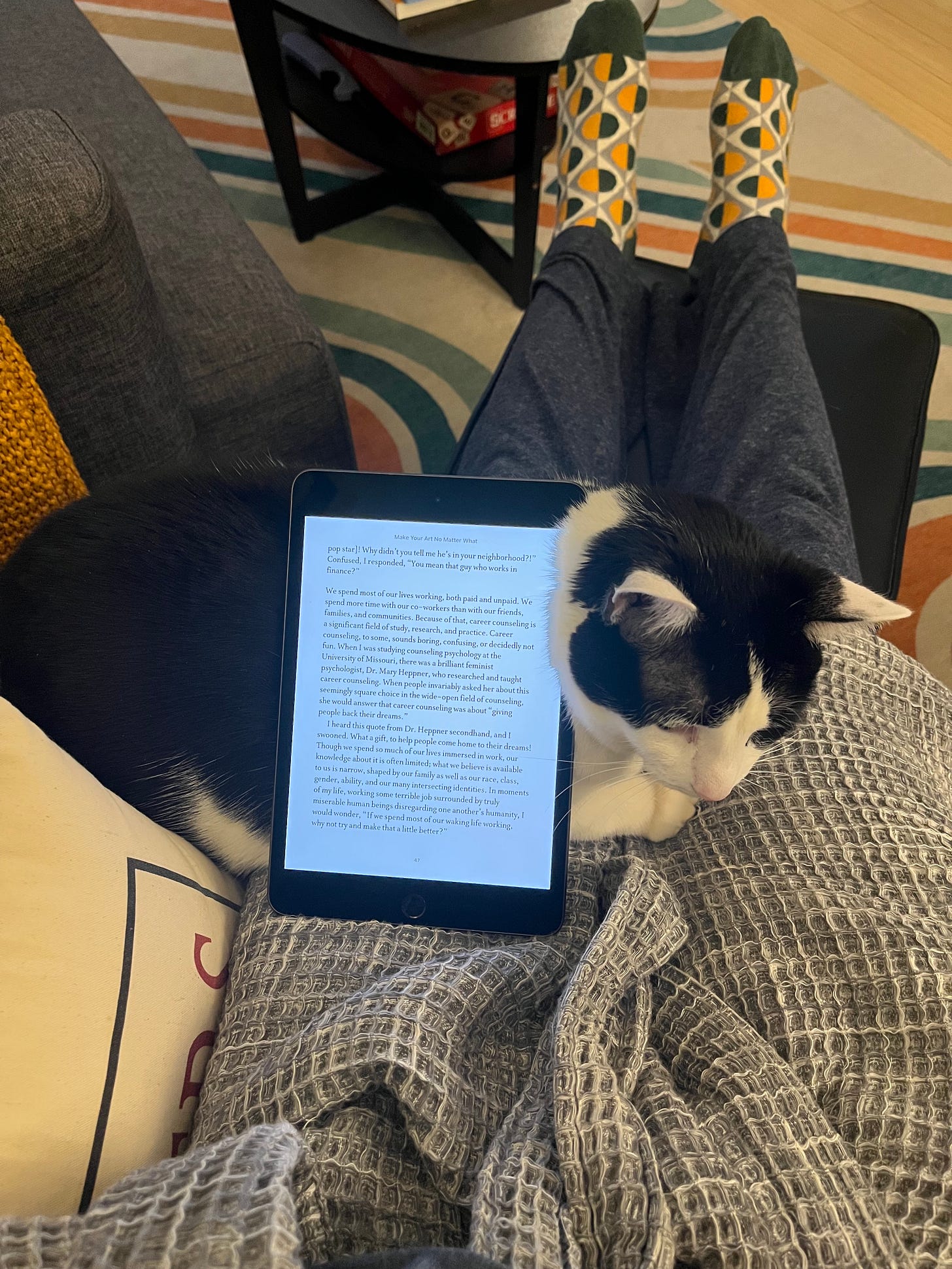Hello, and happy Monday.
I hope that you all had a restful weekend. The first week of classes are beginning this week, and I’m excited to be able to go back onto campus. Harvard required all faculty & staff to work remotely for the first three weeks of January due to Omicron surge. While I value this precaution, I’m itching to get back to the cozy office space I created for myself, and be reunited will all my books once again. 🥰 📚
Here are some pictures I took of my office before the break. I don’t think that there’s anything really revolutionary in my decoration, but I am an absolute stickler for soft lighting. I know that many office spaces and such have that very white fluorescent lighting, but it honestly just makes me feel sad and unproductive. I think it has to do with the fact that I associate the lighting with environments that give me a more nervous energy—like doctor’s offices or administrative buildings. The soft lighting that I’ve gone with allows me to feel like I am in a space where I can really let myself get lost in my work and expression.
✏️ Still processing.
Back in November, I wrote about combatting writing in isolation with zoom co-working sessions. It’s been about two months since I’ve been in regular practice with co-working, so I thought I’d update you all on how it’s going.
I’m happy to say that my mass friend texting spree back in 2021 was successful. From Monday through Friday, I now have a writing buddy to work with each morning starting at 9AM. Each day, I am greeted by the lovely face of a friend also working in academia, and we catch up for a little bit about our week before diving into a few hours of work that is structured by a simple timer and a list of morning goals on a post-it.
Since instating co-working mornings, I’ve felt so much more motivated to keep going and have made some substantial progress in my current projects. Here are some of the reasons why I think that you should text your friends PRONTO to set something like this up—even one morning out of the week!
The consistency of having a set co-working session that does not fluctuate gives me a sense of stability and routine. Considering the fact that most Sunday mornings you can find me curled up on my couch writing tiny driver, you could definitely say that I am a creature of habit and routine. I need the rigid structure of blocking out time for my research and writing, or else ✨other things✨ will just get in the way. Without routine, I dilly-dally. I check my email, I think about the past and the future, etc. etc. By holding myself accountable to someone else—and because that someone else is my friend who I love and care about—I know that my booty will be in my chair at 9AM ready to work.
Co-working helps me muster up the strength to eat the frog at the start of my day. Unless I have something ‼️ ABSOLUTELY IMPORTANT AND URGENT ‼️ that must get done because someone else is depending on me, I reserve this time in my morning for my “frog,” or my most difficult task of the day. This usually has to do with writing or research, as it’s so easy to push off that endeavor for more administrative tasks. Again, the sense of accountability to another person is critical here for me. At the beginning of each writing session, my friend and I say aloud what we are going to get done during our allotted time. This helps me set a reasonable goal that I can complete in the morning and keeps me motivated to try to accomplish it.
It’s so lovely to see a friendly face every morning. I am not the best at working from home, particularly because the isolation means that I don’t get to see my colleagues and friends on a regular basis. The fact that I begin each workday with my friend makes me feel like I have some of that organic daily conversation back in my life, and I’m able to maintain my friendships while still managing to get some work done. It’s also really nice to switch windows and see a face that I know plugging away at their work, just like I am.
I anticipate co-working in the mornings throughout the rest of this year, as long as my friends will let me. 👯♀️
📚 Still reading.
hooks, bell. Teaching Community: A Pedagogy of Hope. New York: Routledge, 2003.
Teaching Community is the second set of essays about teaching that hooks published (I talked about the first one last week). More so than Teaching to Transgress, Teaching Community is grounded in psychology and the mental impact that community has on our ability to confront, resist, and change systems of oppression. Written at a moment when hooks stepped away from the academy and her job at City College in New York, this work speaks to the importance of community, open dialogue, and learning in environments that serve as alternatives to the traditional classroom. While many of the essays still have to do with the pitfalls of the academy at the start of the twenty-first century, many of the sentiments continue to resonate with me, as I think about how I can be of service to my students and cultivate a community of open-mindedness and intellectual risk in the classroom.
Just as with Teaching to Transgress, I wanted to share a few of the essays that stood out to me from this text. I hope that you’ll also have a chance to read them, whether you are a student or a teacher:
“Democratic Education”: Making the distinction between authoritarian professors and democratic educators, hooks argues that education should be thought of as relative to one’s entire life, that it should be made accessible to all people, and that it also occurs outside the institutionalized classroom. This happens when a learning community practices radical openness to chaning one’s mind, brings their whole selves to the classroom, and works to create a closeness among its participants. One of my favorite passages comes from hooks’s commentary on conversation: “Conversation is the central location of pedagogy for the democratic educator. Talking to share information, to exchange ideas is the practice both inside and outside academic settings that affirms to listeners that learning can take place in varied time frames (we can share and learn a lot in five minutes) and that knowledge can be shared in diverse modes of speech,” (44).
“How We Can Serve”: Though it is one of the main ways in which the profession creates community for collaboration in research and knowledge exchange to occur, “service” is not valued as highly as research or teaching when it comes to questions of promotion. In this essay, hooks asks us to re-frame service to see it as a way of building community, particularly with our students—to become a “caring professor.” This is particularly significant for our students of color, who are faced with additional hurdles in their academic journeys. “Committed acts of caring let all students know that the purpose of education is not to dominate, or prepare them to be dominators, but rather to create the conditions for freedom. Caring educators open the mind, allowing students to embrace a world of knowing that is always subject to change and challenge,” (92).
“Moving Beyond Shame”: While the feeling of shame prevents students from learning fully, it is not a feeling that I’ve come across before in writing about pedagogy. hooks shows how shame is intimately tied with racism, making it more difficult for students of color to be fully immersed in their education. In particular, the expectation that students of color are a monolith—that they all fall under the same stereotypes perpetuated and distributed by mass media—create feelings of shame in interactions that show someone holds such a belief. As democratic educators, “we invite students to open their minds and think beyond all trauma of hame. We do this by enacting a politics of affirmation where difference is accorded respect and all voices deemed worthy. As teachers we make the classroom a place where we help students come out of shame. We can allow them to experience their vulnerability among a community of learners who dare to hold them up should they falter or fail when triggered by past scenarios of shame—a community that will constantly give recognition and respect,” (103).
It’s my hope that next week I’ll round out this series with some reflections on hooks’s Teaching Critical Thinking. Stay tuned!
🌀 Still consuming.
In the bookshop:
Currently Reading: Wow, No Thank You by Samantha Irby
On Deck: The Death of Vivek Oji by Akwaeke Emezi
Why yes, I still am obsessed with wordle. Could you not tell?
I continue to feel incredibly grateful that one major component of my job description is writing. I know that many don’t have that luxury. This article talks about how writing is still such an important component of life, even if one has a day job.
This literature clock is absolutely WILD.
Y’all I might be too old for this, but the saga of west elm caleb was crazy.
We! Love! Mitski!
📖 Book club corner.
For January’s book club, we will be reading Make Your Art No Matter What by Beth Pickens! Thank you to everyone who voted, and feel free to purchase a copy of the book here! Details are below.
Here’s the event info:
Date & Time: Tuesday, January 25 @ 5PM PST/8PM EST
Registration Link!
Suggested Donation (for those able to donate): $3-10 through Paypal or Venmo (@idyalz)
A note: Friend and reader of tiny driver Tyler B. sent over this photo of his lovely cat Judy acting as a book rest for Pickens’ text! Join us tomorrow, and you may catch a glimpse of her sleeping very cutely!
🐶 A pup-date.
Current mood: ~pensive~
As always, thanks so much for reading through, and I'll see you in the next one!
Warmly,
Ida











Thank you for the newsletter! Love the co-working idea and the review of hooks's Teaching Community. Also, the literature clock~ wonderful~
This was such a lovely meditation to read. I hope this week is fruitful for you and your writing partners!
I also loved the quote you shared from hooks’s Teaching to Transgress: “ Conversation is the central location of pedagogy for the democratic educator. Talking…is the practice both inside and outside academic settings that affirms to listeners that learning can take place in varied time frames…and that knowledge can be shared in diverse modes of speech”.